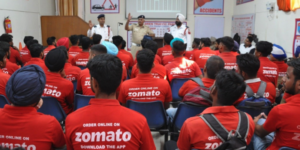Who Does a Good Crop Benefit? Not Farmers. – 2 Articles
Riddles of Mr. Market: Prices Crashing for Farmers, Rising for Consumers!
Subodh Varma
Prices of many essential commodities continue to remain on fire as far as common consumers are concerned. According to the latest price information released by the government, prices of cereals and products have zoomed up by nearly 17% in the past one year, milk and its products have gone through a near 10% price jump, and spices by a whopping 20%. (see chart below)
Prices of some commodity groups have not risen much compared with a year ago, like vegetables or meat and eggs, or oils and fats or pulses. But this is slightly deceptive: some commodities within this group have risen much more than others. For example, tur or arhar dal prices have increased by over 9% but those of masoor and gram have registered a slight fall while urad and moong have increased marginally.
This uneven and seemingly irrational price rise in some commodities has the same effect on family budgets, irrespective of stable prices of other commodities. That’s because some of the key commodities are on fire. The most flagrant case in point is wheat and flour (atta), a staple cereal for a vast number of Indians. In fact, the other equally important staple, rice, too has been witnessing increasing prices, though not as much as wheat.
Wheat Prices Rise Relentlessly
Wheat prices have increased by nearly 12% and atta prices by over 15% over the past one year, according to the latest data provided by the food and consumer affairs ministry. Rice prices in the retail market have increased by nearly 7% in this period.
Wheat price inflation is particularly galling because it started with a mess-up of monumental proportions last year when the government first decided to export wheat, then had to back off due to damage to the crop after an early summer. Procurement plummeted and there was chaos in the Public Distribution System, with the government forcing people to accept rice or bajra in place of wheat in their precious rations.
Despite another good wheat crop being expected (provided the high temperatures do not recur), one would have thought that wheat prices would fall back. But Mr. Market, with the invisible hand of the government helping it along, has pushed them up.
Part of the reason is the government’s decision to scrap the 5 kg foodgrain that was being given free to all persons under the PM Garib Kalyan Anna Yojana, started at the beginning of the pandemic. For a family of four, that means 20 kg wheat gone. The family has to go to the open market to buy that much every month. This is a boon for those traders who have stocked up on the wheat and are straining at the leash to make a quick buck. Although the government released some 2.8 million tonnes of wheat in the open market finally, there are others – like the big companies manufacturing biscuits and other wheat products – who are also in the hunt for buying up wheat or atta. This spiking demand has pushed up prices, again helped along by hoarders and profiteers. It’s a free for all, and small wonder that the hapless common Indian is struggling to buy wheat at these elevated prices.
But Farmers Are Protesting at Crashing Prices of Onion, Potato, Milk….
Meanwhile, a bizarre situation prevails as far as prices of two of India’s most important vegetables are concerned: onions and potatoes. Farmers are up in arms as the selling prices of both these produce have crashed. Potato farmers have taken to the streets in Uttar Pradesh and West Bengal, both top producers of this staple. Even the promise of buying potatoes at a support price of Rs.650 per quintal in UP or of buying up a certain share of produce in West Bengal has not assuaged the farmers, who allege that governments are offering prices way below their input costs.
In Maharashtra, onion farmers are up in arms and had taken out a massive march from Nashik to Mumbai demanding government intervention to save them from crashing prices. The march included farmers of potatoes, cotton and even milk producers. There have been protests from milk producers in Tamil Nadu too.
According to data available at Agmarknet, an online portal of agricultural marketing information run by the agriculture ministry, average wholesale prices for potatoes and onions offered to farmers in markets across the country, suffered a whopping 28% fall between 2022 and 2023. (See chart below)
Potato was sold by farmers on an average at Rs.1,289 per quintal in March 2022 but this year, average prices are down to Rs.923 per quintal. Similarly, onion prices were Rs.1,998 per quintal on an average last year but have fallen to Rs.1,438/quintal this year, as of date.
Strangely – or perhaps not so strangely – consumer prices have not fallen as much, as shown in the graphic below. Farmers’ selling prices are drawn from Agmarknet, while wholesale and consumer prices are from ministry of food and consumer affairs’ database.
While the onion farmer gets an average price of Rs.14.38 per kg., the average wholesale price in urban markets was recorded at Rs.18.05 per kg., and then the consumer or retail price was averaging Rs.23.67 per kg. Similarly for potato: farmers sold their produce for just Rs.9.23 per kg., wholesalers sold at Rs.14.46 per kg., and retails were finally getting it at Rs.19.45 per kg.
In short, while farmers were getting destroyed due to very low prices, the price mark-up was so high along the chain of middlemen that ultimately the consumer bought onions for nearly 65% higher cost than what the farmers got, and potatoes for a jaw dropping 111% more. The middlemen were making a killing at the cost of both farmers and consumers.
This is what happens when the government allows unbridled and unregulated license to private traders to manipulate and hold prices to ransom. Mr. Market is not an unbiased force, it is a tool in the hands of the powerful and the rich.
(Courtesy: Newsclick.)
Who Does a Good Crop Benefit? Not Farmers.
Indra Shekhar Singh
Allahabad/Bulandshahr/Nashik: As the Rabi harvests start, Abhay Singh’s heart begins to sink. He has four acres of rocky land in Baasghat village in the trans-Yamuna area of Allahabad. He toiled all season to grow mustard, wheat and chickpea, hoping that both wheat and mustard harvests would fetch him good prices. But the markets had other plans for Abhay, and the millions of mustard farmers in India. An above average mustard crop has led to prices crashing in most places.
“After seeing a rise in the need for mustard oil, especially after [Prime Minister Narendra] Modi’s call to farmers to grow mustard, I planted mustard too. But now when it’s harvest season, I can’t even get Rs 4,200 for all my mustard crop. Where do we go now? There is no government procurement,” Abhay says.
While the MSP or minimum support price for mustard is around Rs 5,450 yet Abhay says that farmers are getting at least Rs 1,000 less in local mandis. Mandis are state-set up agricultural markets.
Affairs are noisier on the western front – in Rajasthan – too, as mustard crops in many regions there are under the weather.
Farmers in Dholpur, Ajmer, Jaipur, Nagaur, Pali, and other areas came under the spell of untimely rain and hail storms last week, resulting in major damage to the crop. Making matters worse, the hail and rain struck freshly harvested mustard, and in some places the standing crops. Some areas in Pali reported 30% losses in mustard earlier this February. And yet, major market yards (mandis) in Rajasthan, as per the E-Nam website, reported sales below MSP prices, with the lowest prices reaching Rs 3,225 per quintal in Srikaranpur mandi in Rajasthan.
Fateh Singh, a three-acre mustard farmer near Jaipur did not report significant gains this season. “First, the weather affected the mustard crop not only in our area, but various parts of Rajasthan and Madhya Pradesh. And now we are getting, on an average, between Rs 4,100 and Rs 4,400 per quintal. There is no government procurement, so where should we go?”, he asks.
Fateh says he is slightly better off considering that in “Madhya Pradesh, fearing bumper production, the government has not opened procurement and given the middlemen and market a free hand.”
He adds that coriander, which used to sell for Rs 30,000 a quintal, cannot even fetch Rs 5,000 a quintal this season. “Garlic has already been sold for Rs 3-5 a kg. I feel that because farmers didn’t allow for the farm laws to go through, the government is using these ways to push farmers to be looted by predatory market forces,” Fateh says.
His comment came as two of India’s largest edible oil conglomerates – Adani-Wilmar Fortune and Cargill’s Rath brand – along with a network of millers and warehousing middlemen, potentially stand to gain the maximum profits from this mustard price fall. Hoarders and middlemen are quick to fill their godowns with mustard when the prices are low, like they do every year, and farmers and consumers may be systemically squeezed for corporate profits.
If this sounds fantastical, consider how else can one explain the fact that Adani-Wilmar reported 15% profit in December 2022. Not by charity, certainly.
If we look towards India’s favourite staple, potatoes, the scene is no better. To understand the aloo-nomics, I went to the nearest potato belt in Bulandshahr (of Uttar Pradesh) and met up with Guddu Bhatti in Kavara village. Bhatti has been growing potatoes for decades, but has never experienced such hardships. And it’s not the crop yield that’s troubling him, but the prices.
“On an average, farmers in the area spend Rs. 30,000 on aloo seed, Rs 10,000 on soil preparation, Rs 2,000 on water, Rs 5,000-6,000 on fertilisers and pesticides, and another Rs 19,000 on labour (weeding and harvesting) per acre. Even if you take a conservative figure, we are spending Rs 60,000-65,000 per acre on potato cultivation. We get 300 katta (50-52 kg gunny bags) per acre,” the 42-year old explains.
“The selling rate is Rs 200-250 per katta. This leaves nothing for us. Because many of us have taken agri-input loans and have to pay interest. In the end, we can’t even save Rs 2,000 per acre, despite getting a bumper crop,” he adds.
That whole day, I met with other farmers in the area, all of whom complained of similar problems of bumper harvests leading to lower incomes.
“It is not just aloo, for tori [ridge gourd] we are getting Rs 2 a kg. For cauliflower, farmers have refused to sell to the market because the price is Rs 90 -100 per katta, while the harvesting itself costs between Rs 80 and Rs 85. Tomatoes are going for Rs. 50 per 25-kg crate, and carrots for Rs 10 a kg,” Bhatti narrates.
Unfortunately, Bhatti echoes the sentiments of many farmers who are caught in this cycle.
For a picture of how onion farmers have fared, I moved southward towards Nashik in Maharashtra, where I caught up with the APMC (Agricultural Produce and Livestock Market Committee) veteran, 66-year-old Khemraj Kor. In his long career as a farmer, he served for two years as the chairman of Satana APMC mandi and eight years as its director. Satana, near Nashik, is one of the biggest mandis for onions and is comparable to the Lasalgaon mandi. He assured me that onion production was above average, and yet the prices were dismal.
“Growing onions is an elaborate process. From nursery to weeding, to digging, and harvesting – it takes a lot of effort. It is a four-month crop and costs us between Rs 1,350-1,500 per quintal, so about Rs 15,000 per acre. Currently, we are not even getting Rs 300-500 per quintal for our onions. So, what should the farmers do?” Khemraj asks.
He also highlighted that untimely rain and heat waves in the region had affected production, and yet the prices were very low. “Eight to 10 years ago, the price was Rs 700 per quintal, and even today we are not getting that price. The input costs have increased drastically, from diesel to seeds to fertilisers, yet farmers get nothing, and that’s why they are dying by suicide. This season too, three farmers, two from a Scheduled Tribe community, have died by suicide. Prices have crashed in our area,” he adds.
But what is the way out? “Like I have said many times before, there should be MSP for onions and potatoes too. This is the need of the hour. Currently, onions in Varanasi are selling for Rs 25/kg, but farmers in our areas are not even getting Rs 3-4. Even if you add the transportation and storage costs, there is a big margin which is taken by middlemen. If MSP is there, farmers will get a fair deal, otherwise farmers and farming both will be finished,” he says.
As the devil’s advocate, I ask him if all purchases happen at MSP, what will happen to the demand? He looks at me for a second and replies, “Whether you live in a palace or a ghetto, you will eat onions. There is demand for onions everywhere, from Pakistan to Turkey to Russia. If the government gives export subsidies and helps farmers export, we can improve our incomes and also bring good foreign exchange for the country.”
As I finish speaking with Khemraj, it dawns on me that no matter which crop I look at, the pattern repeats itself. A good harvest is no longer good for farmers. It benefits traders, hoarders, middlemen, and corporations more. Without government safeguards through MSP and public procurement, the “free-market” system is rigged against farmers. Each bountiful harvest only heralds doom for them and at once, astronomical profits for a selected few. And in the end, the market always wins in the agri commodity roulette, leaving the farmers sweating, and milking the consumers dry.
(Indra Shekhar Singh is an independent agri-policy analyst and writer, and hosts The Wire’s ‘Krishi ki Baat/Farm Talks’. He was also the former director, Policy and Outreach, NSAI. Courtesy: The Wire.)




